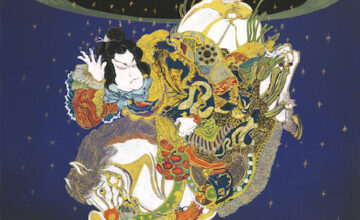[From May Issue 2012]

DVD cover. 117 minutes. 1,890 yen
「愛と死をみつめて <HDリマスター版>」
発売:日活 販売:ハピネット
Gazing at Love and Death (Directed by SAITO Buichi)
Released in 1964, this movie portrays the pure love between KOJIMA Michiko, who suffers from a terminal cancer called chondrosarcoma, and her contemporary, TAKANO Makoto. It is based on the true story of OSHIMA Michiko and KOUNO Makoto, whose collected correspondence was published as a book of the same title.
Michiko and Makoto get to know each other when they are both admitted to an Osaka hospital. Since they are both 18 years old and are both fans of the pro baseball team Hanshin Tigers, they soon become close. Before long they are discharged from hospital and are parted as they begin university life, with Michiko going to Kyoto and Makato to Tokyo. Despite this, they continue to write letters to each other. Unfortunately Michiko is readmitted to the hospital in Osaka as a tumor on her face reappears.
With the money he makes from part time jobs and by pawning his camera and watch, Makoto manages to visit Michiko in the hospital in Osaka many times. They make a pact to visit Makoto’s native Nagano Prefecture to go mountain climbing when Michiko recovers, but Michiko is forced to leave her university in order to fight her illness. Being unsure of her future and taking into account the future of her friend, Michiko bids farewell to Makoto in a letter. However, Makoto is unable to accept this.
The doctor in charge of Michiko’s case recommends that she undergoes an operation to remove tissue from half of her face. The operation is a success. With the left side of her face covered with gauze, Michiko maintains a cheerful disposition, becomes close with the other patients and soon becomes popular. While waiting for cosmetic surgery, she begins studying to become a medical welfare activist. Just then, Michiko discovers a tumor on the right side of her face.
Michiko is once again put on the operating table, but her condition is so severe that the doctor halts the operation. Makato hears about this over the phone and yells at Michiko, “What are the doctors doing? What about the scientists? We can make A-bombs, but cannot even cure such a simple illness?” However, after regaining his composure, he gives encouragement to Michiko, as he used to.
Putting on a brave face for Makoto, Michiko is inwardly preparing herself for death. One day, she cleans her bedside and takes a doll and other things that she has treasured to the incinerator. When asked by the manager whether the items are the belongings of somebody who has died, she quietly answers, “The person is about to die.” Looking up at the smoke coming out of the chimney, she mutters, “We all go up in smoke, don’t we?”
The book this movie was based on was published in 1963 and became a best seller, selling 1.6 million copies. It was not only adapted into a movie but also into several TV dramas as well as a song and, after all these years, still has the power to deeply move audiences. Similar dramas that depict young people caught between life and death have been released in recent years and include: “Sekai no Chuushin de Ai wo Sakebu” (Crying out Love, in the Centre of the World – a story of true love and a fight against illness – and “Ichi Rittoru no Namida” (One Liter of Tears) – a series based on the diary of a woman who died at the age of 25 after struggling with an incurable disease. These two titles also became big hits.
[2012年5月号掲載記事]

DVDジャケット。117分。1,890円。
「愛と死をみつめて <HDリマスター版>」
発売:日活 販売:ハピネット
愛と死をみつめて(斎藤武市 監督)
軟骨肉腫という難病におかされた小島道子と、高野誠の純愛を描いた作品として1964年に公開された。実話であり、原作は大島みち子と河野実が交わした手紙をまとめた同名書簡集。
道子と誠は大阪の病院で入院中に知り合う。18歳の同い年であり、プロ野球の阪神タイガースのファンであることから、すぐに仲良くなる。やがて二人は退院し、道子は京都で、誠は東京で離れて大学生活を送るが、文通を続ける。しかし、顔の腫瘍が再発した道子は、再び大阪の病院へ入院する。
アルバイトで金を貯め、カメラや腕時計を質屋に入れ、誠は何度も大阪の道子を見舞う。道子が元気になったら、誠の故郷である長野県へ一緒に山登りに行く約束をするが、道子は大学を辞めて本格的な闘病生活をせざるをえなくなる。自分の将来を不安に感じた道子は、誠の将来を考えて手紙で別れを告げる。だが、誠はそれを受け入れない。
主治医の勧めで、道子は顔の半分の組織を取る手術を受け、無事に成功する。顔の左半分がガーゼでおおわれた道子だったが、持ち前の明るさでほかの患者たちとも親しくなり、たちまち人気者になる。そして、顔の整形手術を待ちわびながら、医療福祉活動家になるための勉強を始める。そんな矢先、道子は顔の右側にしこりができたことに気づく。
再び道子は手術台に上がるが、状態があまりにひどく、医師は手術を中断する。それを知った誠は、電話口で「医者は何してんだ。学者はどうしたんだ。原爆までつくったくせに、こんな病気が治せないのか」と、道子に怒りをぶちまける。だが、誠は冷静さを取り戻すと、今までのように道子を励ます。
一方の道子も、誠の前では元気にふるまうが、内心では死を覚悟する。ある日、道子はベッドサイドを整理し、大事にしていた人形などを焼却炉に持ち込む。管理人から、誰か亡くなった人の物かとたずねられると、道子は「これから亡くなるとこなの」と静かに答える。「みんな煙になってしまうのね」とつぶやき、煙突からのぼる煙を見上げる。
この映画の原作は1963年に出版され、160万部を売り上げる大ベストセラーになった。映画化だけではなく、何度もテレビドラマ化され、歌も作られ、時代を経ても人々に感動を与え続けている。また、本作のように若者の生と死を題材にした近年公開の作品に、闘病生活と純愛をテーマにした「世界の中心で、愛をさけぶ」や、難病と闘った末に25歳で亡くなった女性の日記を基にした「1リットルの涙」などがあり、大ヒットした。




